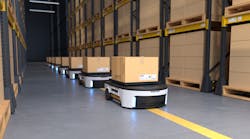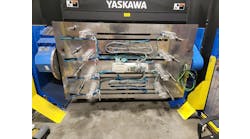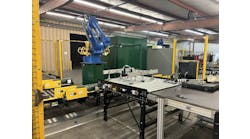In facilities where routine handling of materials and other day-to-day tasks are performed on a regular basis, we often see an opportunity to automate these tasks in an effort to preserve valuable manpower, which can be applied to higher-value tasks that require hands-on and dedicated employees. One of the many methods of automation that we see being utilized are automated guided vehicles (AGVs) and autonomous mobile robots (AMRs).
While functionally the same in principle, both perform basically the same job, but there are some important differences worth discussing as each has its own unique place in the automated factory. It is best to consider the pros and cons of each to better understand what best suits our needs as we look toward automating our systems for higher productivity.
The name of each does a fairly good job of describing how they are used. The AGV, for example, is an automated guided vehicle, meaning that the vehicle follows a predefined guide, path or rail that determines Point A and the path to Point B for that vehicle. The vehicle is equipped to carry payloads from Point A to Point B and has sensors that help it to intelligently determine if something is in the path that has been prescribed. These can be motion sensors, cameras or other types of electronics that help it avoid collisions as it’s traveling to its destination.
These vehicles tend to be lower-cost for the vehicle unit itself but do require extensive planning in the facility to determine the predefined pathways that are to be traveled by the unit. Once installed, they are reliable and consistent in their functions, but they do have a number of drawbacks.
Automated guided vehicles do have the ability to determine when something is in the way of their path and stop, which will prevent a collision. While this obviously is very useful, it has the disadvantage of delaying the delivery of the goods to the endpoint due to the inability of the AGV to go around an obstacle, so, until the obstacle is removed or moves, the AGV will sit in place as it is programmed to do.
One of the other drawbacks to AGVs is that the cost of redeployment is high. If any of the automated systems change, then the track or guide must be re-engineered according to the new plan. Thus, any new changes to the automated system must be weighed against the cost of re-engineering the driveways and guides of the AGV, as well as the logistics of that plan.
One way to think of an AGV is as a roller coaster. The cars have a start point and an end point and will have that same path thousands of times, according to the original plan. Imagine how difficult it would be to reroute a roller coaster if suddenly there was a need to change. Many factors would have to be considered, including, but not limited to cost, engineering, rebuilding and redeployment.
Autonomous mobile robots, on the other hand, are units that can be deployed readily from point to point and deliver a payload much like an AGV, but they have several distinct advantages that may offset the higher upfront cost of the vehicle.
Due to their programmable nature and ability to have artificial intelligence (AI) onboard, they will be able to work out the most efficient route between A and B as they travel. This is because they have an onboard computer and a route map that allows them to learn their environments and make real-time decisions as they encounter objects that would cause an AGV to stop.
When an AMR would travel and encounter an obstacle, it has the ability to reroute itself around the obstacle and continue moving to its final destination without the delay experienced by the AGV when it experiences an obstacle. Additionally, the AMR can be easily rerouting itself for new paths as the demands of the automated system change. The AMR is able to change directions on its own without a programmer being required, deliver a payload in a reasonable amount of time to meet expectations and rapidly adapt to changing situation and production demands. The ability of an AMR to adapt itself to its environment while consistently delivering goods is one of the greatest advantages. While some may consider the initial upfront cost as being prohibitive, the long-term analysis should show that the upfront cost is more than easily offset by the advantages of the adaptability in the automation.
One of the greatest challenges of automation is that once you get started down a certain path, you are pretty well stuck to that path until the end of its usable life. That’s always a challenge because the nature of our economy and the manufacturing world is always in flux and changes very rapidly with little to no notice. Any time we can add adaptability to automation, we find ourselves with a great advantage over a fixed unchangeable system that requires much cost and change and labor to make even the smallest changes.





